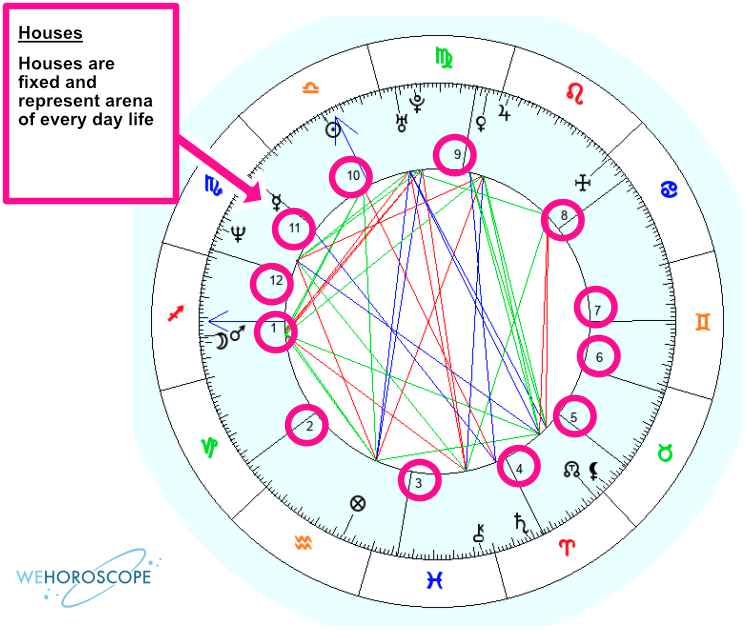Some astrologers believe that your dominant planets and signs in your birth chart may have an even greater influence on you than your sun sign. Determining what your dominant planets and signs are is half the fun of reading your Birth Chart.
Most birth chart reports, including WeHoroscope’s reports, give you interpretations based on where the individual elements lie, but the interpreter needs to look beyond the report at the bigger picture to see how they all fit together.
Identifying these dominant planets and signs helps identify major themes in a person’s personality and life. (Learn about planetary aspects and astrological Houses in our article on how to interpret a birth chart.)
On this page
Four Kinds of Dominant Planets
- Planets lying the sign it rules
- Planets that fall on angular or cardinal houses
- Planet has a lot of aspects in relation to other planets
- Solitary in the Hemisphere
Four Kinds of Dominant Signs
Dominant Planets
1. Planet lying in the sign that it rules
A planet is considered to be dominant if it lies in the sign that it rules on your birth chart.
For example, the ruling planet of Aries is Mars: if the planet Mars has an Aries background on the chart, Mars is a very powerful planet in your birth chart and would have a more powerful influence than other planets on the Birth Chart.
Below the Moon is considered to be a dominant planet in this chart
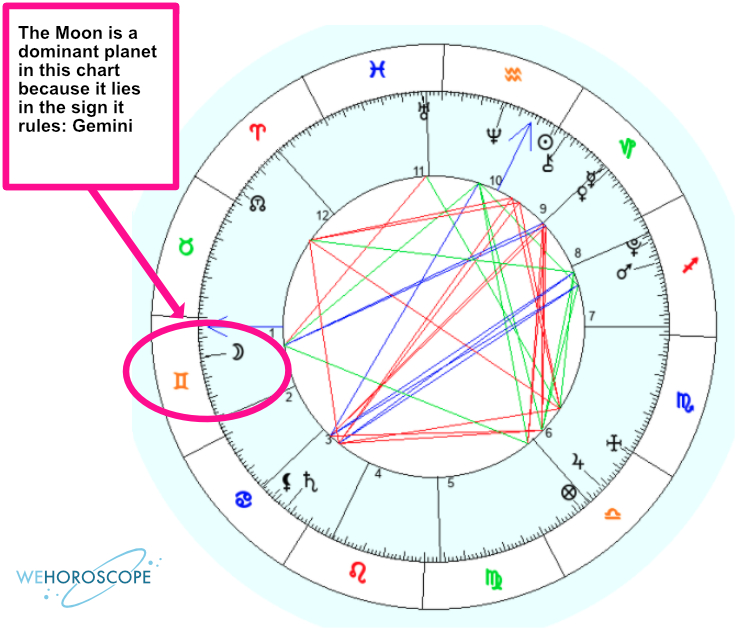
Planets and Points in the Night Sky and their Symbols
Signs and the planet that rules them
| Sign | Sign Symbol | Ruling Planet | Planet Symbol |
|---|---|---|---|
| Aries | ♈ | Mars (and/or Pluto) | Mars – ♂ Pluto – ♇ |
| Taurus | ♉ | Venus | ♀ |
| Gemini | ♊ | The Moon | ☽ |
| Cancer | ♋ | Mercury | ☿ |
| Leo | ♌ | The Sun | ☉ |
| Virgo | ♍ | Mercury | ☿ |
| Libra | ♎ | Venus | ♀ |
| Scorpio | ♏ | Mars | ♂ |
| Sagittarius | ♐ | Jupiter | ♃ |
| Capricorn | ♑ | Saturn | ♄ |
| Aquarius | ♒ | Saturn (and/or Uranus) | Saturn – ♄ Uranus – ♅ |
| Pisces | ♓︎ | Jupiter (and/or Neptune) | Jupiter – ♃ Neptune – ♆ |
2. Planets that fall on the Angular (or cardinal) houses
Astrological Houses
In astrology, the night sky is essentially divided up into 12 “houses” (starting at the “9 o’clock” position on the chart and heading counter-clockwise).
As the earth spins, the sun and other planets are in each of these houses for approximately two hours (as there are 24 hours in a day) as do other planets.
As astrology is an ancient art very grounded in our place in the universe and on earth, there are four points in the day that are considered most important and each is associated with a house:
- Sunrise (Ascendent) – first house
- Midday (Mid-Heaven) – fourth house
- Sunset (Descendent) – seventh house
- Midnight (lower-Heaven) – tenth house
These are known as Angular Houses.
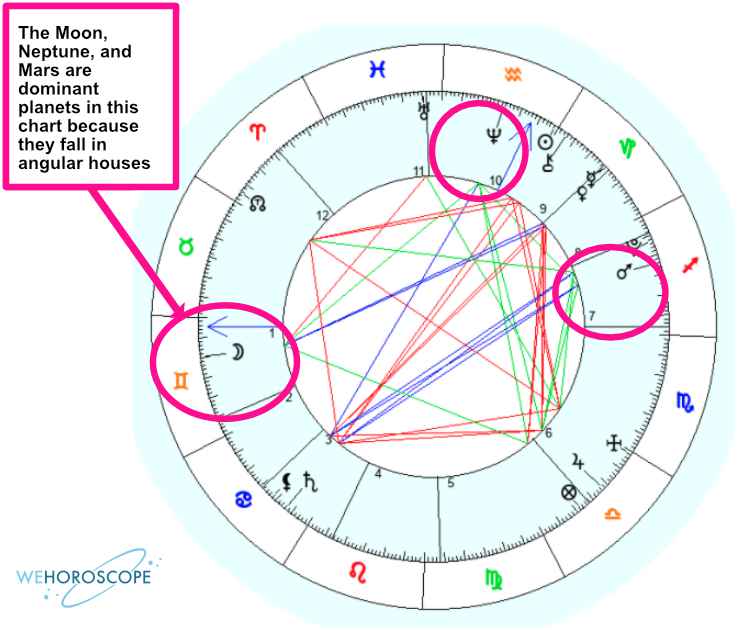
Angular Houses
Planets (each associated with their own signs) that fall on the Angular (or cardinal) houses are considered to have the greatest impact on a Birth Chart.
First House – Ascendant
You will often hear astrologers talk about Ascendants. That is because the planet that falls on the Ascendent can overshadow even the sun sign. The Ascendant often falls on the cusp of the first house on the chart. The first house influences the person’s personality and behavior.
Fourth House – Imum Coeli
Imum Coeli is often found near the cusp of the fourth house. The fourth house represents a person’s home and family. It has a strong parental aspect which also means it represents security.
Seventh House – Descendant
The Descendant is usually found near the cusp of the seventh house. It represents the kind of partners people are attracted to.
Tenth House – Mid-heaven
Mid-heaven is often near the cusp of the tenth house and refers to what we produce for the world and how we are seen by the world. This can refer to career, creative output, our vocation, etc. It can also relate to our children (since we create them).
3. Planet has a lot of aspects in relation to other planets
If a planet has a lot of significant aspects in relation to other planets, it can have a dominating influence on the Birth Chart.
Aspects
Aspects are the angles between the planets as seen from Earth (Earth being in the middle of the chart). In other words, if you map out your planets on your birth chart, you can literally create a triangle by drawing a line between them and back to Earth in the middle. This way you can give them an angle (remember geometry?) as it relates to your middle position of Earth.
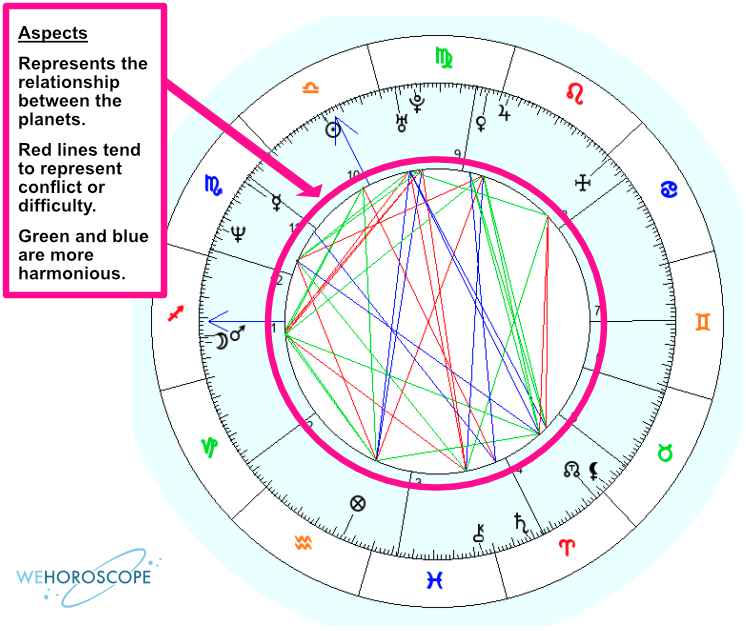
So if one planet is at the 12 o’clock position, and another is at the 9 o’clock position and you draw lines between the two and also from the planets back to Earth, the degree of angle at Earth is 90 degrees (a square aspect).
How they relate to one another in your life has an impact on you and this is particularly fascinating.
Hard Aspects
Some aspects are called hard aspects, such as the square aspect, and signify challenges, conflicts, or energy blocks. These tend to be red on a birth chart.
Harmonious Aspects
Other aspects are called easy or harmonious aspects and these signify beneficial influences and potential, (although can also be taken too far if indulged too much). These are typically represented by green or blue.
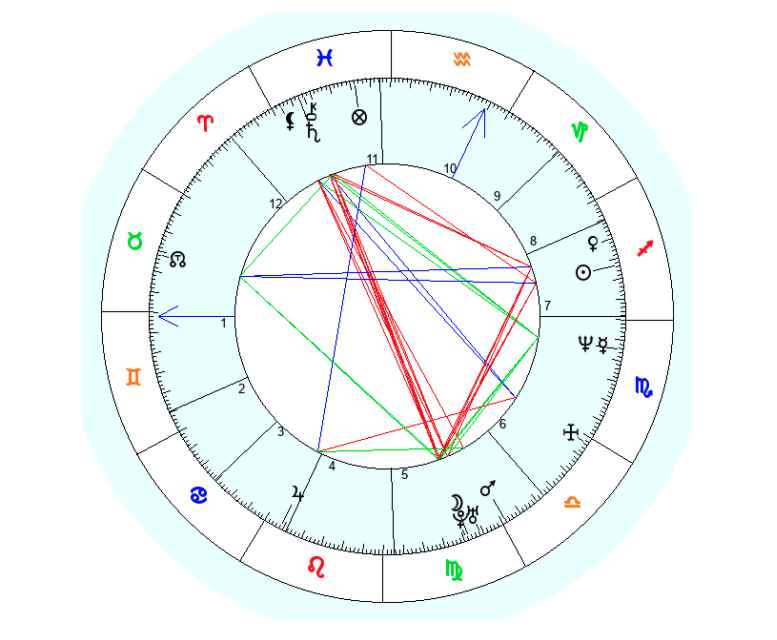
Aspect Relationships At A Glance
Often in a birth chart, you will also get a natal grid like this image below which can help you get an overview of the chart quickly.
This is just a different and less complex representation of the birth chart below. In the example below, you can quickly see the square that represents the relationship between the Sun in Virgo and the Moon in Taurus. You can also quickly see which plants have more aspects than others.
Example
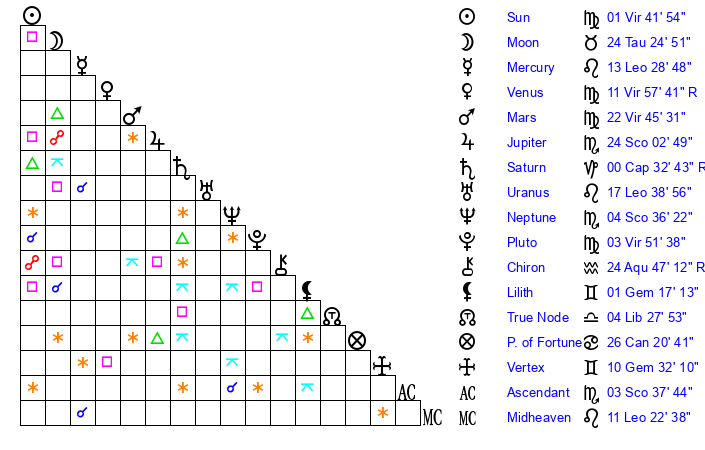
The difficulty between Sun and Moon is easy to see here, but this may not be as much of a difficulty as there is between the Moon and Jupiter, which is one of only two direct oppositions on this chart represented by the symbols in red in the grid.
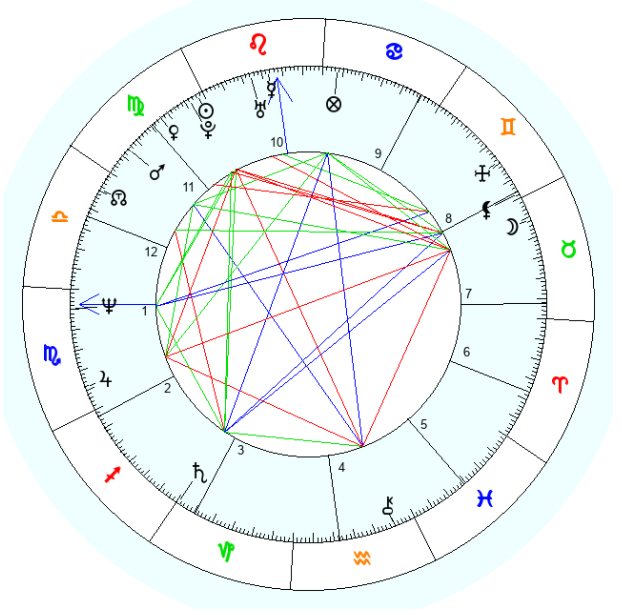
4. Solitary in the Hemisphere
If the planet is the only planet in the hemisphere, then this can have a strong influence and therefore is considered a dominant planet in the chart.
The Southern Hemisphere is actually at the top of the birth chart. Simply stated this hemisphere is characterized by extraversion. The Northern Hemisphere is at the bottom of the chart and relates to introversion and the inner world. It is concerned with the outer world.
The Eastern Hemisphere relates to identity while the Western Hemisphere relates to other people and relationships.
Dominant Sign
1. The Sun Sign
The Sun sign is obviously an important one and the one we are most familiar with. When you learn you are a Capricorn or a Gemini for example, this refers specifically to your sun sign, meaning what constellation the sun was in front of when you were born.
This is not the same as where the sun passes through the houses during the day. Rather it is more specifically related to where the earth was in terms of orbiting the sun throughout the year.
2. Signs Representing Elements and Quadruplicities Groupings
Look at the signs that are the background of your planets in your birth chart. Each sign has both an Element (Earth, Water, Air, Fire) and Quadruplicities (Cardinal, Fixed, Mutable).
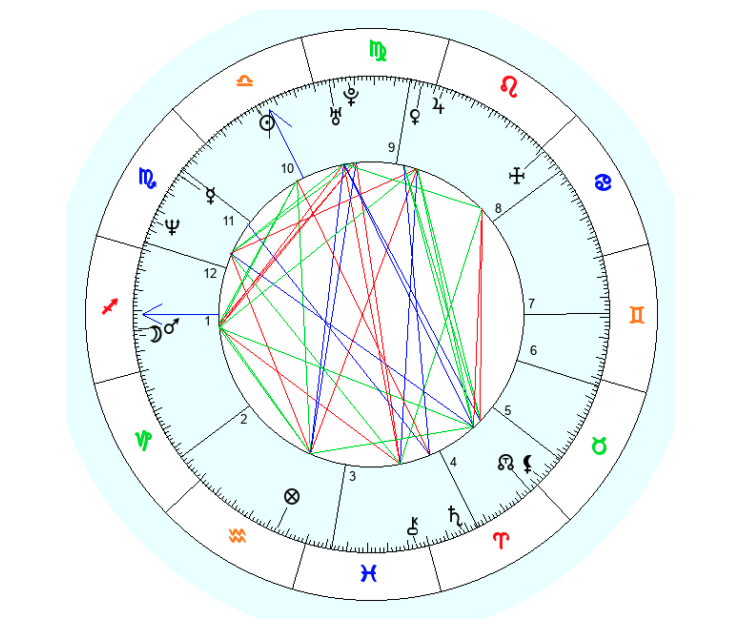
Map them out in a chart similar to the one below. For example, if you have two planets in Aquarius, you could put a two in Aquarius’s box.
| Fire | Air | Earth | Water | |
|---|---|---|---|---|
| Cardinal | Aries | Libra | Capricorn | Cancer |
| Fixed | Leo | Aquarius | Taurus | Scorpio |
| Mutable | Sagittarius | Gemini | Virgo | Pisces |
Example
For example, in the example below, the table and the birth chart show more Fire signs than the others and more Mutable signs than the others. The sign that has both these qualities, in this case, is Sagittarius. Therefore Sagittarius is a dominant sign in this chart even though they have more planets in Virgo.
| Fire | Air | Earth | Water | Score | |
|---|---|---|---|---|---|
| Cardinal | Aries √√ |
Libra √ |
Capricorn – |
Cancer √ |
4 |
| Fixed | Leo √ |
Aquarius √ |
Taurus √ |
Scorpio √√ |
5 |
| Mutable | Sagittarius √√ |
Gemini – |
Virgo √√√ |
Pisces √ |
6 |
| Score | 5 | 2 | 4 | 4 |
3. Ascendant’s ruler
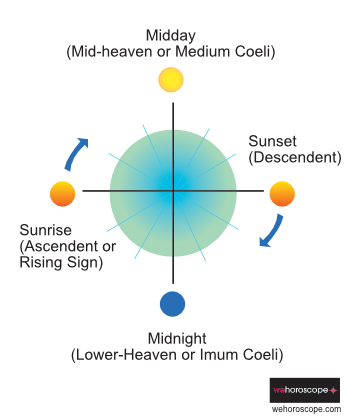
You need to know your birth time to accurately get your ascendant’s degree. The ruler of your ascendant (or your Rising Sign) is the planet that rules over your ascendant sign – both planets and sign have a significant influence that should be considered.
If you don’t know the time you were born, you could try this app to do a birth chart rectification. It will take you through possible qualities and significant moments in your life to calculate possible times you were born.
4. Several planets in a sign
If several planets appear in the same sign, this sign has a powerful influence.
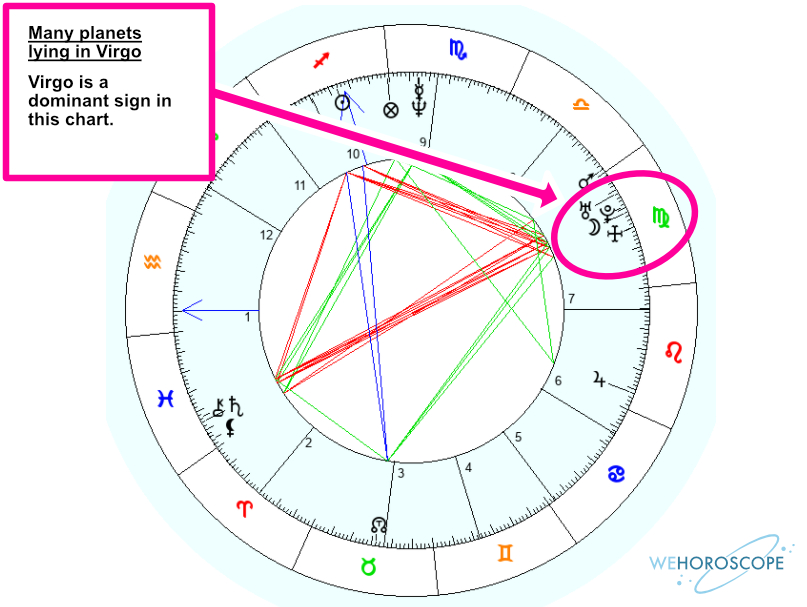
Learn about planetary aspects and astrological Houses in our article on how to interpret a birth chart.


